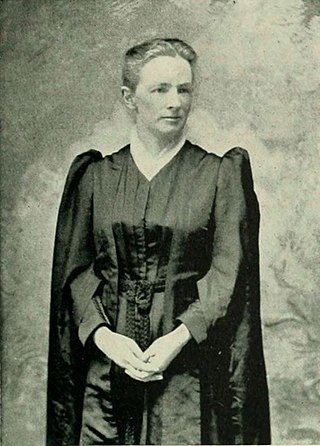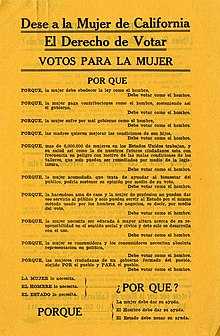
Yolanda Margarita López was an American painter, printmaker, educator, and film producer. She was known for her Chicana feminist works focusing on the experiences of Mexican-American women, often challenging the ethnic stereotypes associated with them. Lopez was recognized for her series of paintings which re-imagined the image of the Virgen de Guadalupe. Her work is held in several public collections including the Smithsonian American Art Museum, the San Francisco Museum of Modern Art, and the Los Angeles County Museum of Art.

Proposition 4 of 1911 was an amendment of the Constitution of California that granted women the right to vote in the state for the first time. Senate Constitutional Amendment No. 8 was sponsored by Republican State Senator Charles W. Bell from Pasadena, California. It was adopted by the California State Legislature and approved by voters in a referendum held as part of a special election on October 10, 1911.

Caroline Maria Seymour Severance (1820–1914) was an American abolitionist, suffragist, and founder of women's clubs.

The College Equal Suffrage League (CESL) was an American woman suffrage organization founded in 1900 by Maud Wood Park and Inez Haynes Irwin, as a way to attract younger Americans to the women's rights movement. The League spurred the creation of college branches around the country and influenced the actions of other prominent groups such as National American Woman Suffrage Association (NAWSA).

Latin American feminism is a collection of movements aimed at defining, establishing, and achieving equal political, economic, cultural, personal, and social rights for Latin American women. This includes seeking to establish equal opportunities for women in education and employment. People who practice feminism by advocating or supporting the rights and equality of women are feminists.
Ellen Carol DuBois is a professor of history and gender studies. She has taught at the University at Buffalo and ended her career at the University of California, Los Angeles (UCLA). DuBois retired from UCLA in 2017. She is known for her pioneering work in women's history and for her history books.
Una Richardson Winter was a Southern Californian club woman, women's suffrage leader, and director of the Susan B. Anthony Memorial Committee of California.
Myra Virginia Simmons was a California suffragist and leader of the Colored American Equal Suffrage League (CAESL). She was a prominent Bay Area community organizer who served as Chair of the Women’s Civic and Progressive League in Oakland.
This timeline provides an overview of the political movement for women's suffrage in California. Women's suffrage became legal with the passage of Proposition 4 in 1911 yet not all women were enfranchised as a result of this legislation.

Women's suffrage in California refers to the political struggle for voting rights for women in the state of California. The movement began in the 19th century and was successful with the passage of Proposition 4 on October 10, 1911. Many of the women and men involved in this movement remained politically active in the national suffrage movement with organizations such as the National American Women's Suffrage Association and the National Woman's Party.

Nina Samorodin was born in Kiev, Russian Empire to a Jewish family. Samorodin took advantage of increasing educational opportunities available to Jews in the city and graduated from Kiev University. After immigrating to the United States in 1914, she became involved in both union and women's activism. Samorodin was a factory worker and then general organizer of the Shirt Makers’ Union of Philadelphia. She was the executive secretary of the National Labor Alliance for Trade Relations with and Recognition of Russia. By 1922, she was also the secretary of the Women's Trade-Union League. Additionally, she taught at the Rand School of Social Science in New York City. However, Samorodin is most well known for her work with the National Woman's Party.
Selina Solomons (1862–1942) was a California suffragist active in the 1911 campaign which resulted in the passage of Proposition 4. Solomons wrote a first hand account of the movement titled, "How We Won the Vote in California".

Florence Collins Porter was an American newspaper editor, clubwoman, political campaigner, and activist for temperance and women's suffrage.

Eliza Mason Tupper Wilkes was an American suffragist and Unitarian Universalist minister.

Claiborne Catlin Elliman was a 19th to 20th-century suffragist and political leader. Elliman's main political participation during her lifetime was in the suffrage movement and she was an active member of the National American Women Suffrage Association, otherwise known as NAWSA. She organized rallies, advocated for women, and spread information about suffrage throughout Massachusetts on horseback, where she lived for a large portion of her life.
Mary Elizabeth Simpson Sperry was a leading California suffragist who served as president of the California Woman Suffrage Association.

Minora Ellis Kibbe was a social reformer and suffragist from California. She ran for a seat on the San Francisco area school board in 1908, and for California's 36th State Assembly district in 1918.

The California Equal Suffrage Association was a political organization in the state of California with the intended goal of passing women's suffrage.












